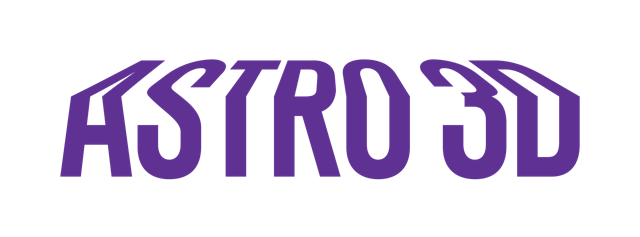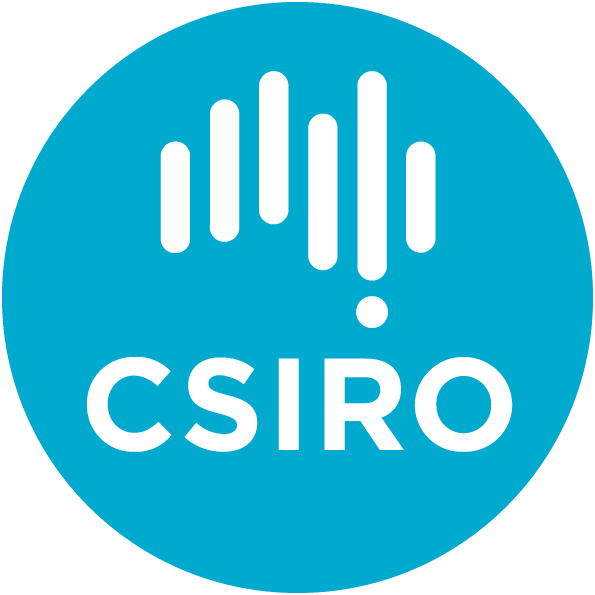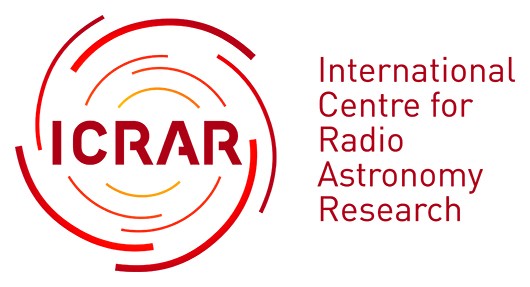February 2025
Editor: Manasvee Saraf
Foreword
MANASVEE SARAF
Welcome to the February 2025 edition of the WALLABY newsletter! Over the past six months, things have been looking up, with a successful run of WALLABY full survey observations, the publication of the second public data release, several presentations of WALLABY science at the IAU general assembly and six new papers focused on WALLABY data accepted for publication!
In this issue, the PIs highlight improved data quality but slower-than-expected observations due to scheduling constraints, as well as the SWAN Universe collaboration’s meeting to plan theoretical work. The project scientist encourages team members to explore new WALLABY data and reminds them to submit proposals for WALLABY science projects. We also welcome four new members who have joined us since August 2024. Li Wang, Qifeng Huang, Mathieu Perron-Cormier and Benne Holwerda provide updates on their recently accepted or published papers. Manreet Kaur, Paula Boubel & Matthew Colless present their ongoing work on updating the WALLABY Tully-Fisher Relation. Finally, members are encouraged to keep up this collaborative spirit by participating in current projects and upcoming meetings and workshops!
Happy reading !
Message from the PIs
LISTER STAVELEY-SMITH & BARBARA CATINELLA
With all the WALLABY pilot survey observations publicly released, the focus is now on full survey. As detailed below, the switch to nighttime observations has dramatically improved the quality of the data, leading to a 100% acceptance rate. However, observations have not progressed at the rate that we hoped for, as the requirement for nighttime makes scheduling WALLABY less efficient for the Observatory (lengthy calibrations are needed to switch between bands/surveys). As a result, at the beginning of 2025, the number of accepted full survey tiles reached 4.4% completion, i.e. 49 out of a total of 1104.
On the bright side, we have now over 1500 new HI detections waiting for the first round of WALLABY full survey science papers, so please submit new project proposals!
In other news, the Simulations for Wallaby And the Nearby Universe (SWAN Universe) collaboration met in Perth the first week of last December (Fig. 1) to plan theoretical work that is highly relevant to our team, with Barbara Catinella and Kristine Spekkens giving WALLABY survey and kinematics overview talks at the beginning of the workshop. We look forward to seeing what will come from these promising simulations. On the topic of meetings, there is already a great list of upcoming conferences and workshops very relevant to WALLABY, such as the Hungry HIppos conference at Kruger Park in August and the PHISCC 2025 meeting in Cagliari in September. Please let us know if you intend to present WALLABY results at these conferences, so that we can coordinate.

Message from the Project Scientist
KAREN LEE-WADDELL
As you will read in the next section of this newsletter, accessing new WALLABY data is just a few clicks away for team members. Every field offers the opportunity to discover something different, perhaps challenge current paradigms, and ultimately deepen our understanding of the Universe. So, let’s dive into the WALLABY full survey data with passion and determination, knowing that the answers we might uncover could lead to the next big leap in science!
This is also a reminder to put in your proposals for WALLABY science projects using the form linked through the internal Redmine wiki. Proposals will be reviewed to minimise overlaps and will be used to coordinate activities within the WALLABY team.
WALLABY progress update
by Tobias Westmeier
After a long hiatus due to various technical problems at the Pawsey Supercomputing Centre, full WALLABY survey observations finally commenced in earnest on 19 October 2024. To avoid interference from the active Sun, WALLABY observations are currently being carried out during the night. This has resulted in a substantial improvement in data quality, and all of the 24 footprints observed between mid October and mid December 2024 have been accepted after quality assessment which corresponds to an unprecedented acceptance rate of 100%. A particularly spectacular example of a section of a recently observed WALLABY footprint in the direction of the nearby interacting spiral galaxy NGC 1512 is shown in Fig. 2.
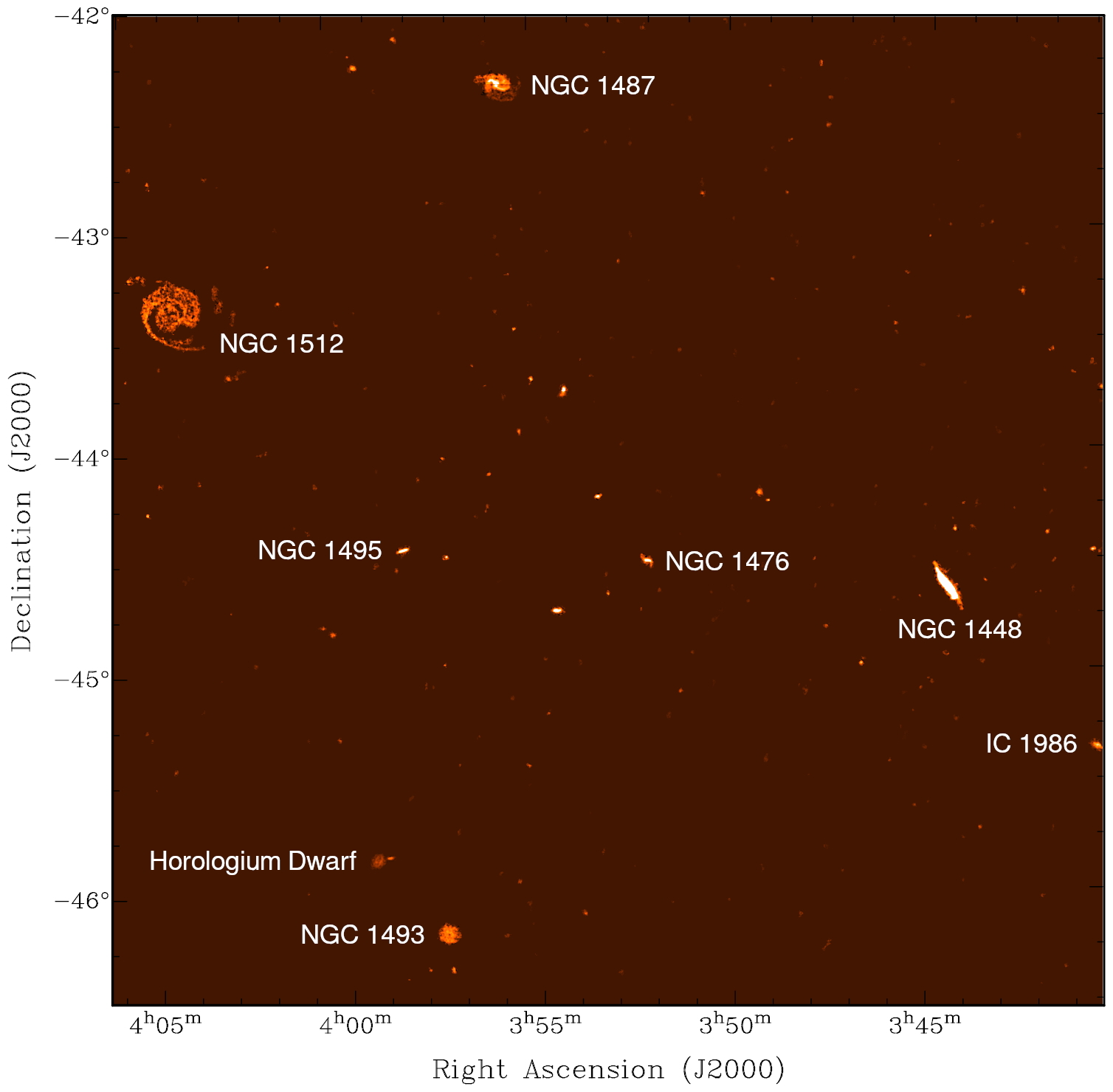
The data quality is generally superb, with no signs of significant radio frequency interference or artefacts in the majority of the new observations. In addition, we are now routinely collecting both 8-hour footprints of a sky tile in close succession. 14 full-sensitivity sky tiles have already been completed so far, covering more than 400 square degrees of sky. Galaxy catalogues for more than 1500 galaxies extracted from the central 4° × 4° of each of the full tiles have already been internally released to the WALLABY team for scientific analysis. Combined with the WALLABY pilot survey, this already gives the team access to a total sample of almost 4000 galaxies which approaches the size of the HI Parkes All-Sky Survey (HIPASS) sample, but at much better spatial and spectral resolution (30″ / 4 km/s versus 15.5′ / 18 km/s). Fig. 3 plots HI mass versus redshift for all pilot + full survey detections so far, illustrating the excellent and continuous redshift coverage all the way out to z ≈ 0.085. Many of the detected galaxies are at least marginally resolved by the 30″ Australian SKA Pathfinder (ASKAP) beam (see Fig. 1), thus enabling spatially resolved studies of the neutral gas component across large statistical galaxy samples for the first time.
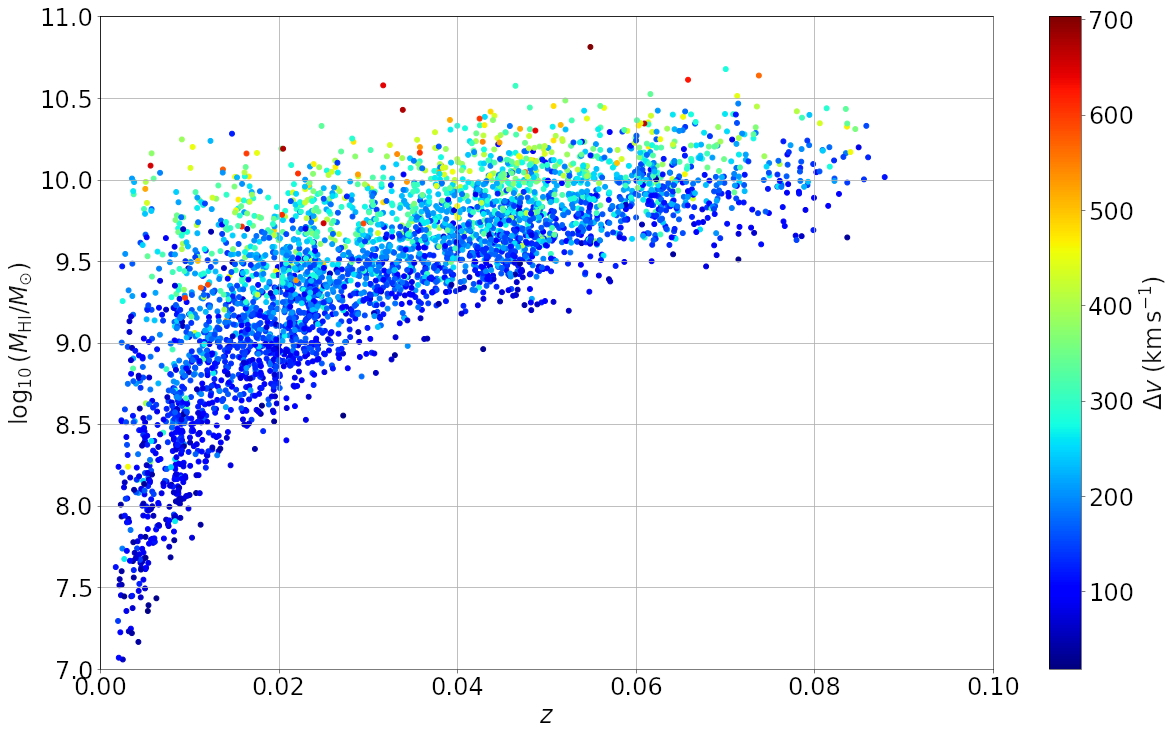
Following the planned interruption of ASKAP spectral-line observing over the Christmas and New Year break, WALLABY observations resumed in late January, and we expect to continue to make substantial progress with the survey throughout the remainder of this year.
Second WALLABY public data release
by Tobias Westmeier
The WALLABY team is pleased to announce the release of the next batch of value-added data products from the WALLABY pilot survey to the general public. This second public data release (PDR2) includes source catalogues, images and spectra for about 1800 galaxies detected in HI emission during phase 2 of the WALLABY pilot survey at the standard 30″ resolution in addition to kinematic models for more than 120 spatially resolved galaxies. For the first time, additional cutouts at 12″ resolution of 80 galaxies detected in the direction of HIPASS sources located in the phase 2 pilot fields have been released as well. The galaxies were detected with ASKAP in three separate regions on the sky in the direction of the NGC 4808 and NGC 5044 (Fig. 4) galaxy groups and the Vela supercluster region.
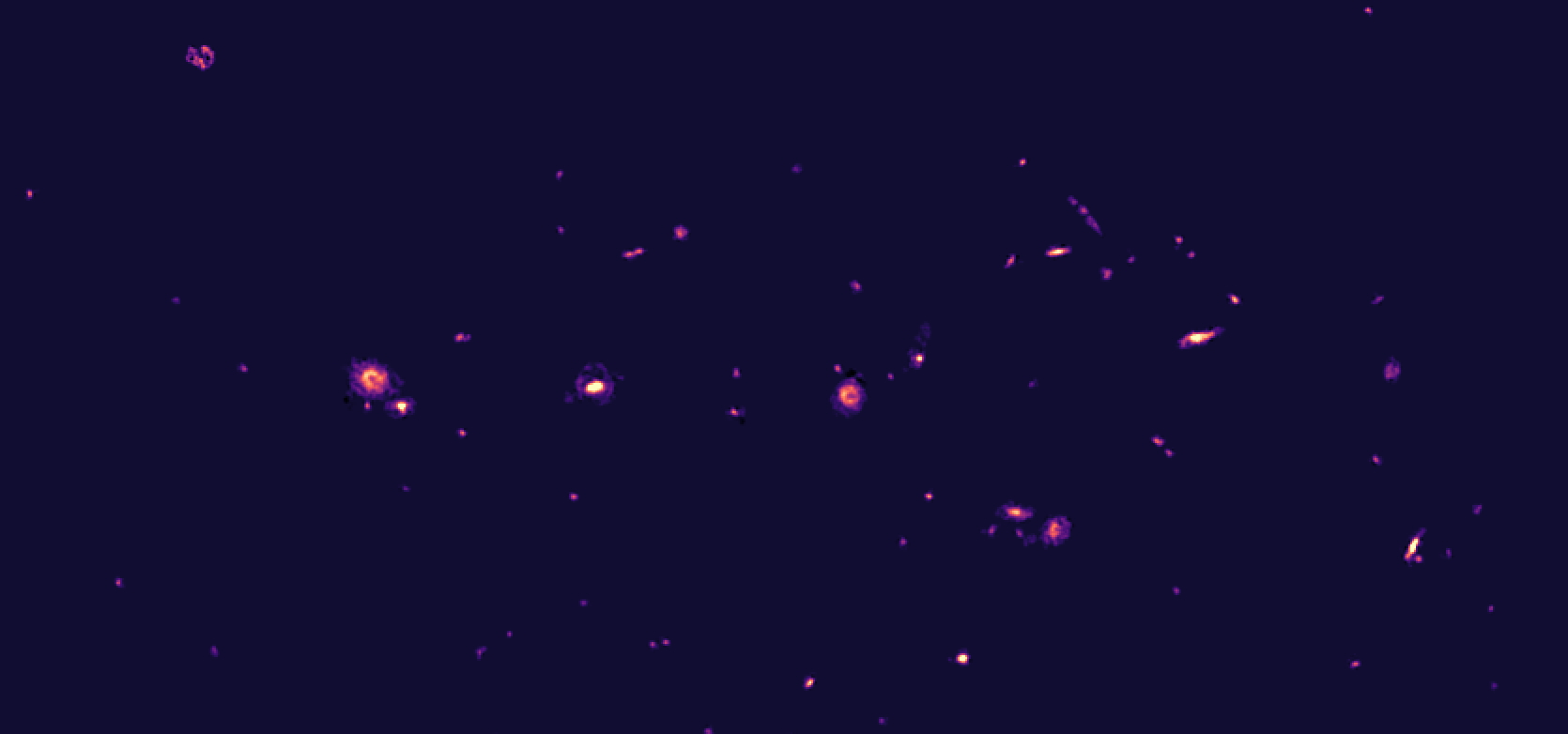
The data can be obtained from the Canadian Astronomy Data Centre (CADC) and the CSIRO ASKAP Science Data Archive (CASDA), either through a web browser or via TAP/ADQL. Detailed instructions on how to access the data have been made available on the WALLABY website at https://wallaby-survey.org/data.
The data release is accompanied by a paper describing the source finding and resulting HI source catalogue as well as the kinematic modelling of galaxies. This paper was published in Publications of the Astronomical Society of Australia (PASA) and provides a detailed description of the available data products and their limitations. With full WALLABY survey observations now officially under way, regular releases of full survey data to the public are expected to occur over the coming years as the survey progresses.
IAU General Assembly in Cape Town
by Tobias Westmeier
The WALLABY team was well-represented at last year’s IAU General Assembly which took place in Cape Town, South Africa, from August 6–15, 2024. Several team members presented their WALLABY science highlights in talks or on posters at the IAU Symposium 392 on “Neutral hydrogen in and around galaxies in the SKA era” during the second week of the GA.
Most notably, WALLABY team members Kristine Spekkens and Kyle Oman delivered plenary talks on “Looking to the future of HI observations: from pathfinders to the SKA” and “Looking to the future of simulations of HI”, respectively. WALLABY-focused science presentations were given by Matthew Colless, Rayssa Guimarães-Silva, Federico Lelli, Xuchen Lin, Jing Wang and Tobias Westmeier. In addition, Nathan Deg, Bi-Qing For and Tamsyn O’Beirne presented posters showcasing WALLABY science results.
It was also great to see WALLABY being mentioned in presentations by other speakers, e.g. in the talks by Erwin de Blok, Sambatriniaina Rajohnson, Martin Meyer, Deanne Fisher and Bo Peng. WALLABY science also featured in the IAUS 392 conference summary delivered by Thijs van der Hulst who highlighted some of the work by Seona Lee and Bi-Qing For (Fig. 5).
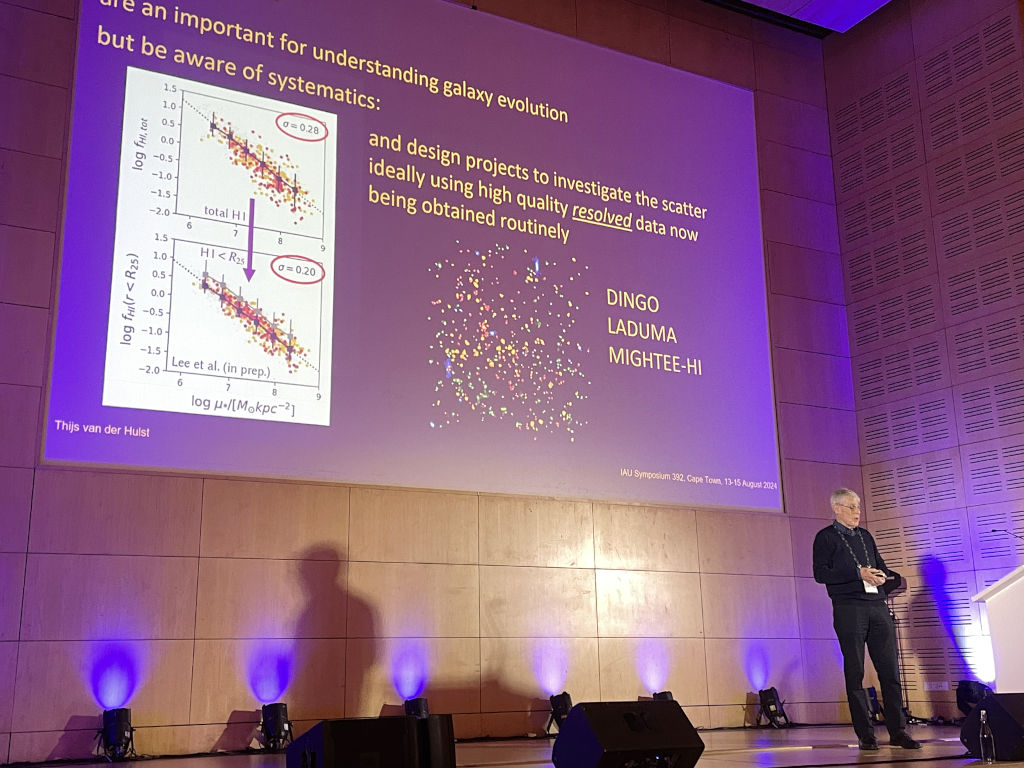
Overall, it was fantastic to see WALLABY make an impact at the IAU GA which is testimony to the excellent data and science that the survey is already producing even in its early days. Thank you to all of the WALLABY team members who presented their work in Cape Town and contributed to a successful conference. If you missed some of the talks, there is still the chance to watch them online, as all of the sessions have been recorded and made available on YouTube.
New Member Profiles
Jasjeet Singh Bagla
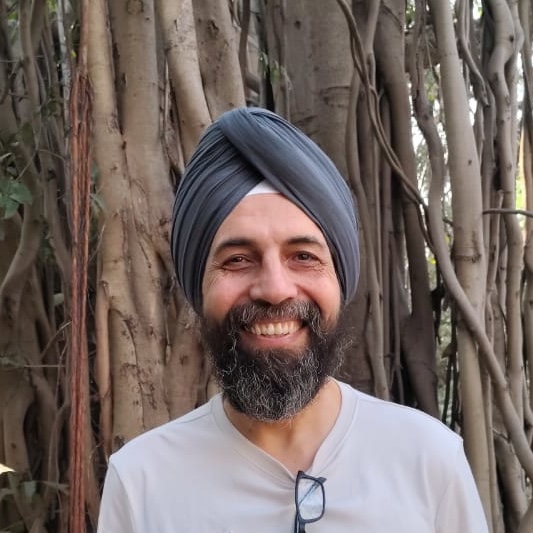
I am Jasjeet Singh Bagla and at present I am a professor at the Indian Institute of Science Education and Research Mohali (IISER Mohali) in India. I did my PhD at the Inter-University Centre for Astronomy and Astrophysics (IUCAA) in Pune, India, followed by post-doctoral stints at the Institute of Astronomy, Cambridge (UK), and then at the Harvard-Smithsonian Center for Astrophysics, Cambridge (MA, USA). I worked at the Harish-Chandra Research Institute in Prayagraj (erstwhile Allahabad) for more than a decade before joining IISER Mohali in 2010.
My research has been on topics related to formation of galaxies and large scale structures in the Universe. Within this area I have worked on diverse topics. I have used cosmological N-Body simulations to make predictions about prospects of detecting the redshifted 21 cm line from high redshift galaxies and the large scale structure with radio interferometers. I have also participated in a study of the Extended Groth Strip with the upgraded Giant Metrewave Radio Telescope (GMRT).
Presently, I am working on problems related to the generation of mock catalogs for HI studies using the SKA and its precursors.
Rasha Eldaly
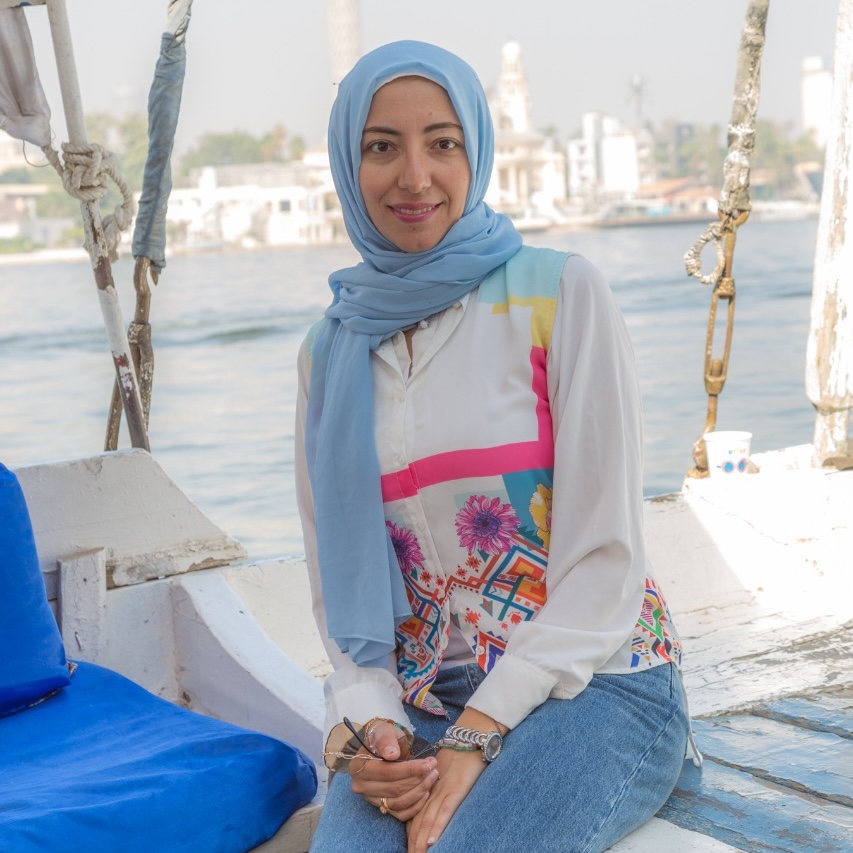
Hello! I’m Rasha Eldaly, a researcher at the Astronomy Department of the National Research Institute of Astronomy and Geophysics (NRIAG), Cairo, Egypt. I obtained my PhD in Astrophysics from the Faculty of Science at the Cairo University. Currently, I am a member of the SKA Extragalactic Continuum working group and HI Galaxy Science working group.
My research primarily focuses on the evolution of early-type galaxies in different environments such as galaxy groups and galaxy clusters. I am inspired by radio galaxies, which play an important role in the evolution of galaxies and clusters. I’m also very interested in studying tidal features and gas streams in galaxies, which indicate past interactions and mergers. These help investigate the role of environment in shaping galaxy morphology and dynamics, and how galaxies exchange material with their surroundings.
I am very excited to join the WALLABY team. By analyzing the amount and distribution of HI in galaxies from WALLABY, I can understand the processes that drive galaxy growth, such as mergers and interactions, and how they have evolved over cosmic time.
Sauraj Bharti
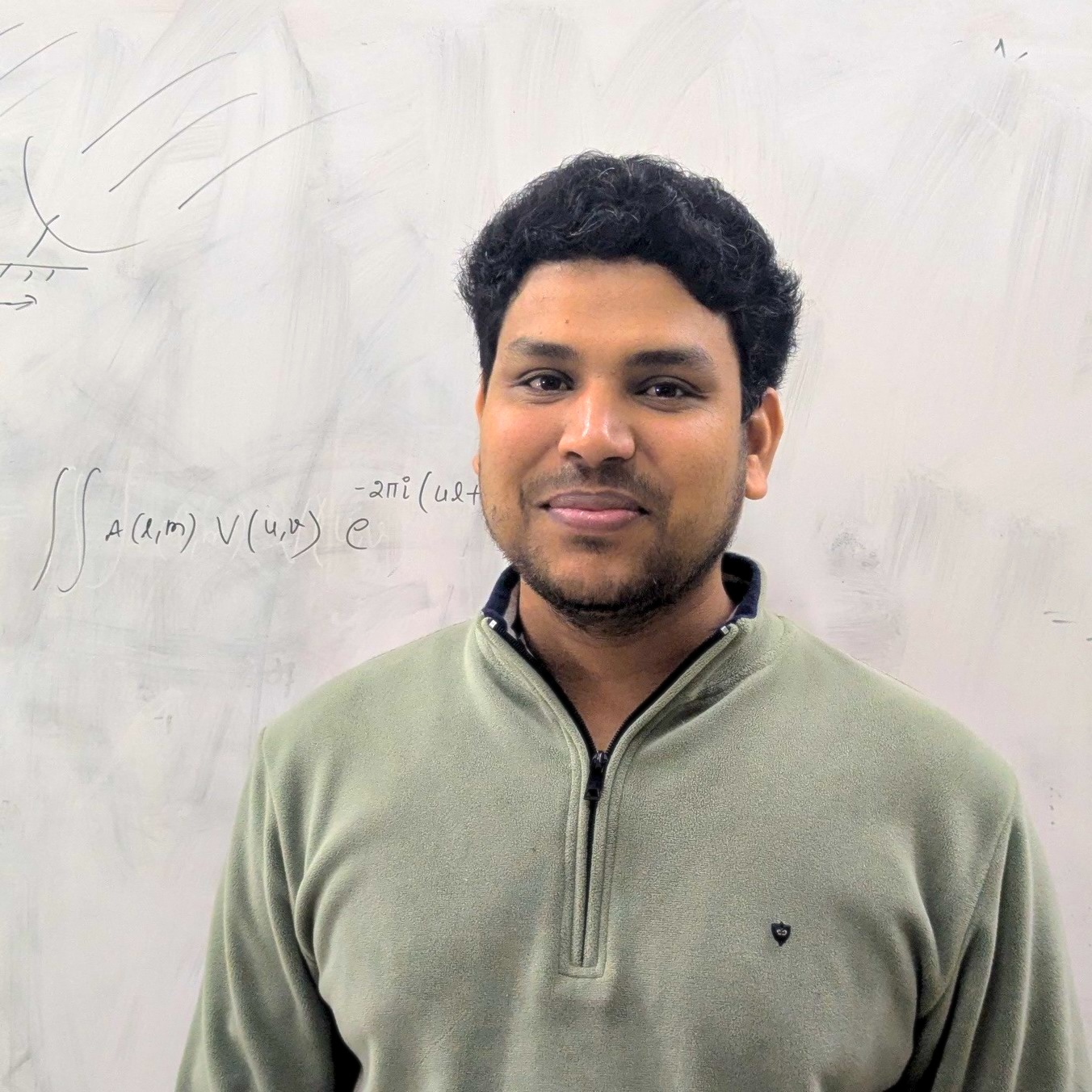
Hi, I am Sauraj Bharti, a PhD student at IISER Mohali, India.
I work in galaxy evolution and my research focuses on simulating HI-stacking and blind detection of the redshifted 21 cm emission for the ongoing SKA precursor surveys: WALLABY and MIGHTEE-HI. I use the sensitivity of SKA’s precursors – ASKAP and MeerKAT – to create mock observations. With WALLABY having a large survey area, I expect a large number of direct detections in different cosmic environments. Using the mock observables, I aim to constrain the HI mass function (HIMF) through Bayesian and direct methods. This analysis can also be applied to actual observations from WALLABY, helping us better understand the role of the HIMF in galaxy evolution and the impact of cosmic variance on the HIMF measurements.
It is exciting to join the WALLABY collaboration, where I can validate our predictions and contribute to WALLABY science.
Teymoor Saifollahi
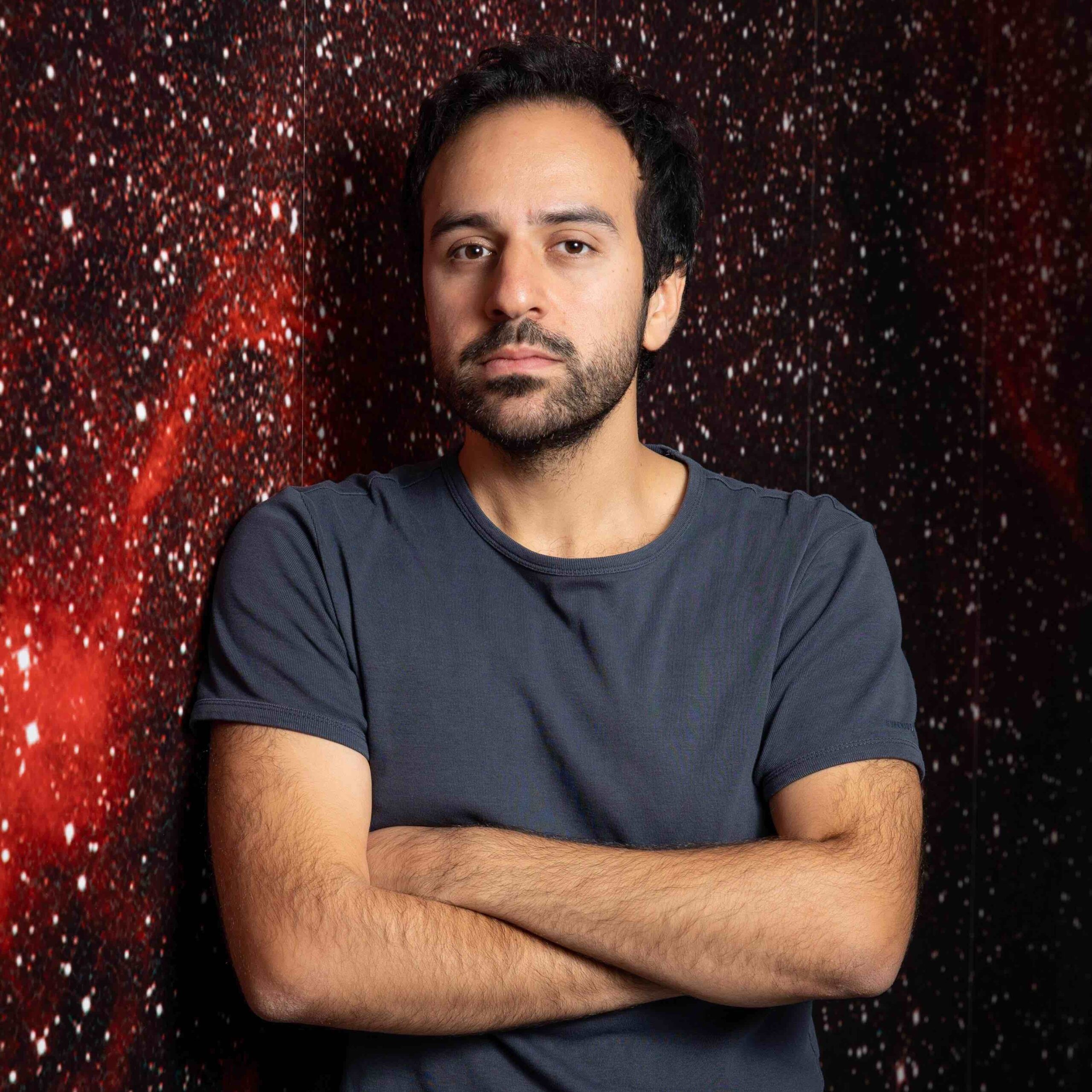
Hello 21 cm enthusiasts! My name is Teymoor and currently I am a postdoctoral fellow at the Observatory of Strasbourg, France. I got my PhD in 2022 from the Kapteyn Astronomical Institute in the Netherlands.
I am mainly interested in studying dwarf galaxies and globular clusters, using optical/near-infrared observing facilities, and nowadays, mostly the Euclid Space Telescope.
Recently, I have joined WALLABY to work on synergies between Euclid Wide Survey and WALLABY for studying Local Universe dwarf and low-surface brightness galaxies. In the meantime, I’d like to contribute to the ongoing research/projects on dwarf galaxies and other multi-wavelength synergies.
HI source-finding with a machine learning framework
by Li Wang
The data volumes generated by WALLABY necessitate greater and reliable automation in source-finding and cataloguing. To this end, I introduce and explore a novel deep learning framework for detecting low Signal-to-Noise Ratio (SNR) HI sources in an automated fashion.
The proposed method, detailed in a paper accepted for publication in PASA and illustrated in Fig. 6, provides an automated process for separating true HI detections from false positives when used in combination with the Source Finding Application (SoFiA) output candidate catalogues. Leveraging the spatial and depth capabilities of 3D Convolutional Neural Networks (CNNs), our method is specifically designed to recognize patterns and features in three-dimensional space, making it uniquely suited for rejecting false positive sources in low SNR scenarios generated by conventional linear methods.
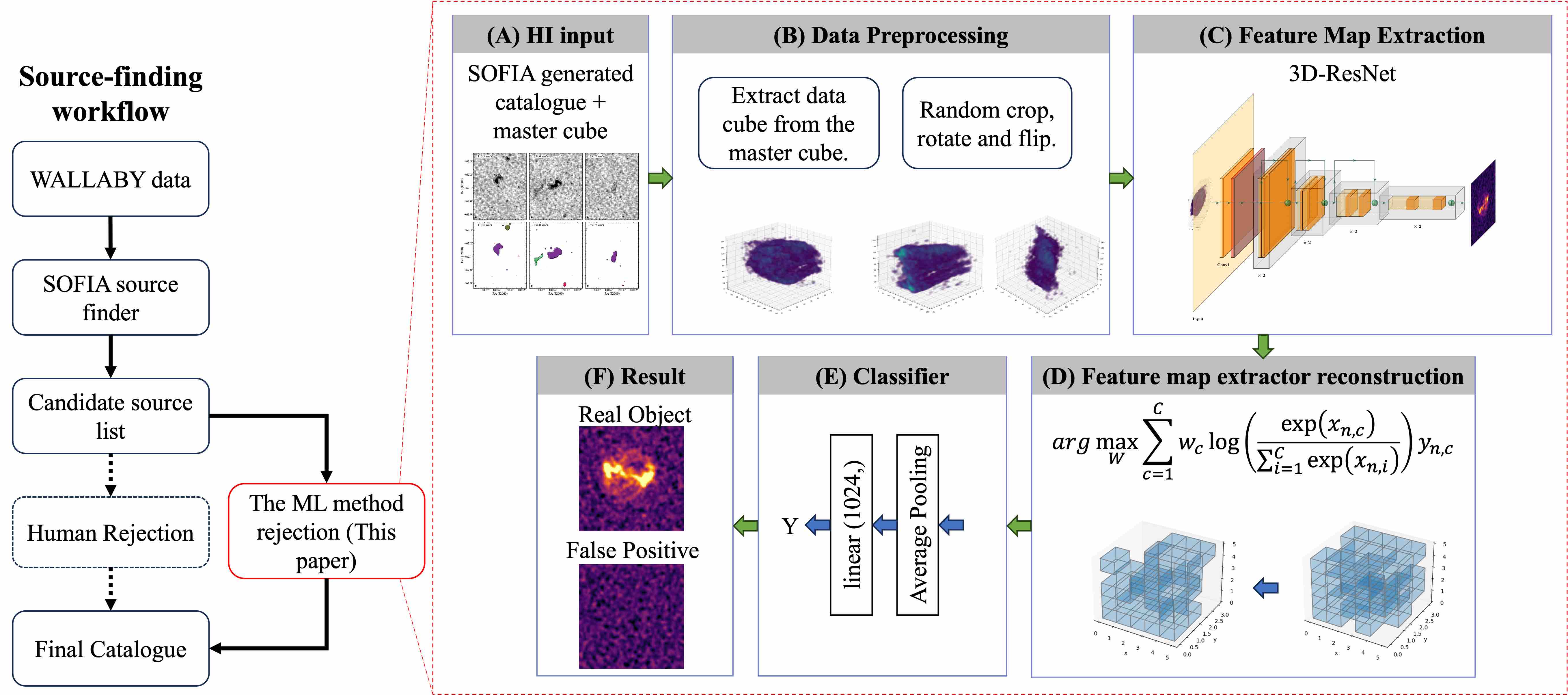
This approach is significantly more accurate in source detection and results in considerably fewer false detections compared to previous linear statistics-based source finding algorithms. Performance tests using mock galaxies injected into real ASKAP data cubes reveal this method’s capability to achieve near-100% completeness and reliability at a relatively low integrated SNR ≈ 3 – 5. An at-scale version of this tool will greatly maximise the science output from upcoming widefield HI surveys.
The SFR enhancement and suppression of HI-rich galaxy pairs in WALLABY
by Qifeng Huang
WALLABY provides a large sample of interacting galaxies with spatially resolved HI data, allowing us to quantify, in detail, the relationship between HI and star formation rate (SFR) within individual galaxies during their interaction phase.
In a paper accepted for publication in the Astrophysical Journal (ApJ), we construct a sample of 278 interacting galaxies from WALLABY to see how their SFRs varies relative to the isolated control sample at the fixed HI content and stellar mass. The HI masses of the individual galaxies are obtained using our novel 3D-based de-blending algorithm, which has been tested for being able to recover the HI mass in blended galaxy pairs, and which can also be applied to future studies.
We find that high-mass and low-mass galaxies (segregated at 109 M☉) behave differently during the interactions (see Fig. 7). For high-mass galaxies, the SFR deviates from the control (the horizontal zero-line) when the dark matter halo encounters its neighbour (dproj/R200,pair ~ 1) and increases as the tidal interaction strengthens. For the low-mass galaxies, on the other hand, we observe a tentative suppression of their SFRs at intermediate separation (0.3 < dproj/R200,pair < 1), possibly due to the gas stripping. After the HI discs overlap (log rgas < 0), the SFR suppression turns into an enhancement, indicating the importance of hydrodynamic processes in inducing star formation in low-mass mergers. Our results suggest that different mechanisms are at work for galaxies in different mass regimes, highlighting the importance of HI in galaxy interaction studies.
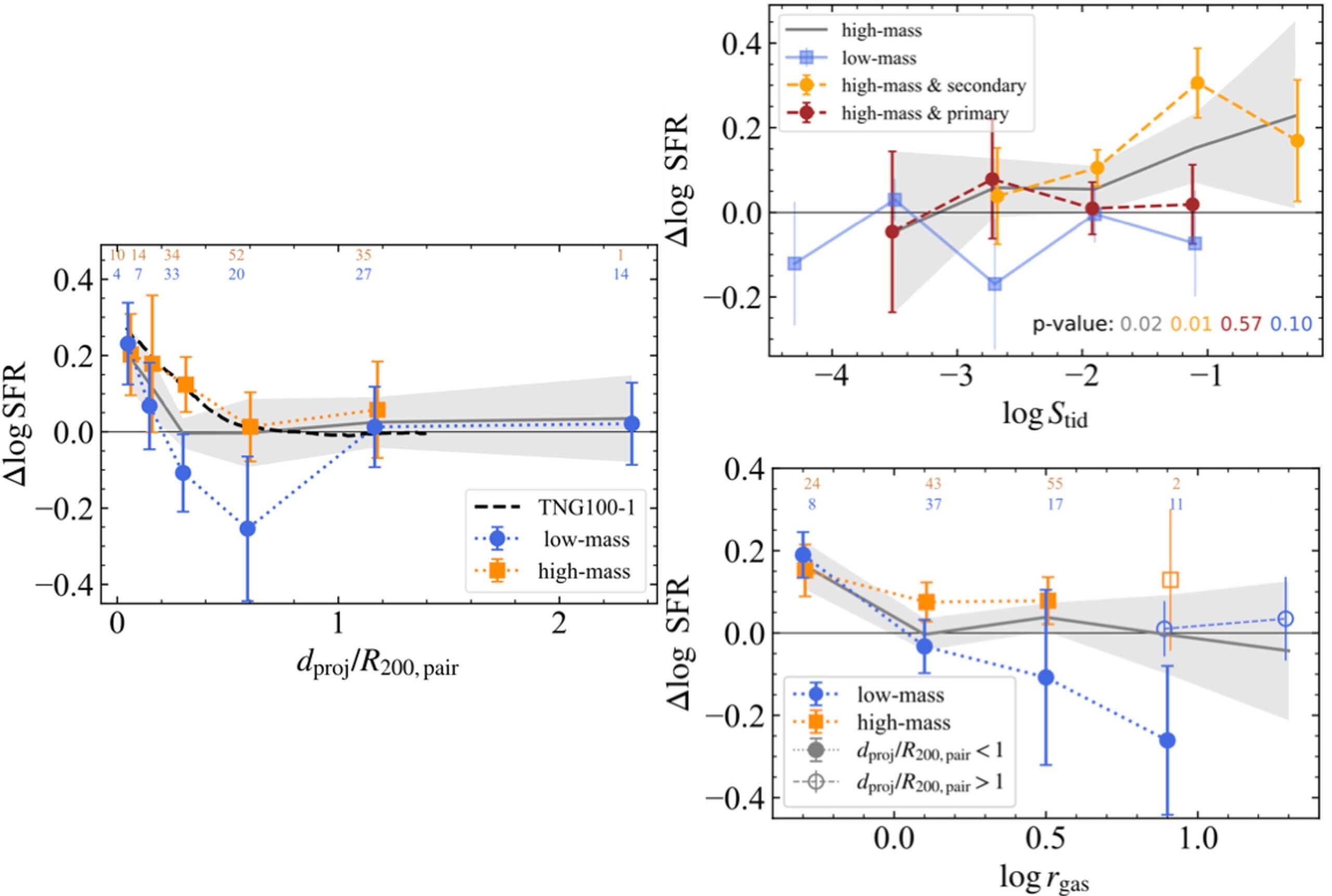
WALLABY Pilot Survey & ASymba: Comparing HI Detection Asymmetries to the SIMBA Simulation
by Mathieu Perron-Cormier
One of WALLABY’s assets is that its statistical power allows meaningful comparisons of galaxy populations between the survey and simulations. As a first effort, we compared the asymmetries of resolved WALLABY pilot survey galaxies to those of mock galaxies in the SIMBA simulation.
In a paper accepted for publication in ApJ, we developed a framework to match detections between WALLABY HI sources and simulations. We also developed a custom scanline tracing method for generating reliable mock HI observations using SIMBA. In our matching algorithm we ensured that the mock galaxies have the same inclination, position, distance, noise, and a comparable HI mass as the initial WALLABY detection.
For our comparison, we calculated the 1D and 3D asymmetry (A1D and A3D, respectively) of each WALLABY detection and each SIMBA mock observation. We then compared the A1D and A3D distributions using the PQMass test. This test determines whether two separate samples are drawn from the same underlying distribution and can be applied to an arbitrarily large parameter space.
Given the number of WALLABY galaxies with robust asymmetry measurements, the PQMass test suggests that SIMBA is consistent with WALLABY. However, there are hints of possible differences at high asymmetries, but we require a larger sample size to confirm this suggestion (see Fig. 8). Fortunately, such a larger sample will soon be available as WALLABY continues to take data. We will also be able to explore how different feedback approaches in the SIMBA simulations affect asymmetries and makes comparisons to results from WALLABY data.
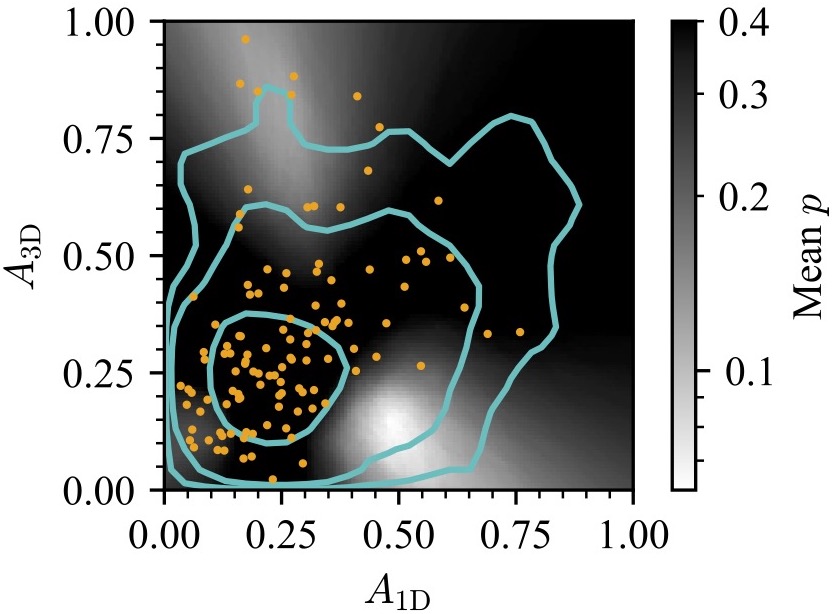
More Machine Learning with WALLABY: kNN identification of perturbed galaxies through HI morphometrics
by Benne Holwerda
In a paper recently accepted for publication in PASA, I explored the effectiveness of machine learning in classifying HI morphologies as perturbed or unperturbed within WALLABY survey fields, using the same morphometrics I have relied on to parameterise HI morphology.
This was made possible thanks to Lin et al. 2023, which classified galaxies in two WALLABY fields into different levels and types of perturbance. With a decent sample size (see the left panel of Fig. 9), it provided a good opportunity to try out some simple machine learning—building on what I’d done in 2011 across various HI surveys and more recently in 2023 on the WALLABY pilot data. Given the limited-sized training set, I simplified the classification into just two categories: perturbed-looking and not. Since these galaxies are closer than those used in my 2023 study, there was reason to think the classification method might perform better here.

I found a nice spread in morphometric values, with some visible separation in the parameter space—promising material for a simple classifier! I went with k-Nearest Neighbours (kNN) because it’s conceptually straightforward: classify a galaxy based on the properties of its nearest neighbours in an n-dimensional space (which doesn’t even need to be orthogonal and, in this case, isn’t). The only thing to tune is the number of neighbours to be used. As shown in Fig. 10, the optimal number of neighbours turn out to be 2, beyond which the metrics for accuracy, precision and recall diverged and degraded. However, since using only two neighbours provided a small sample, I ran the train-test loop multiple times to get a sense of the average performance.
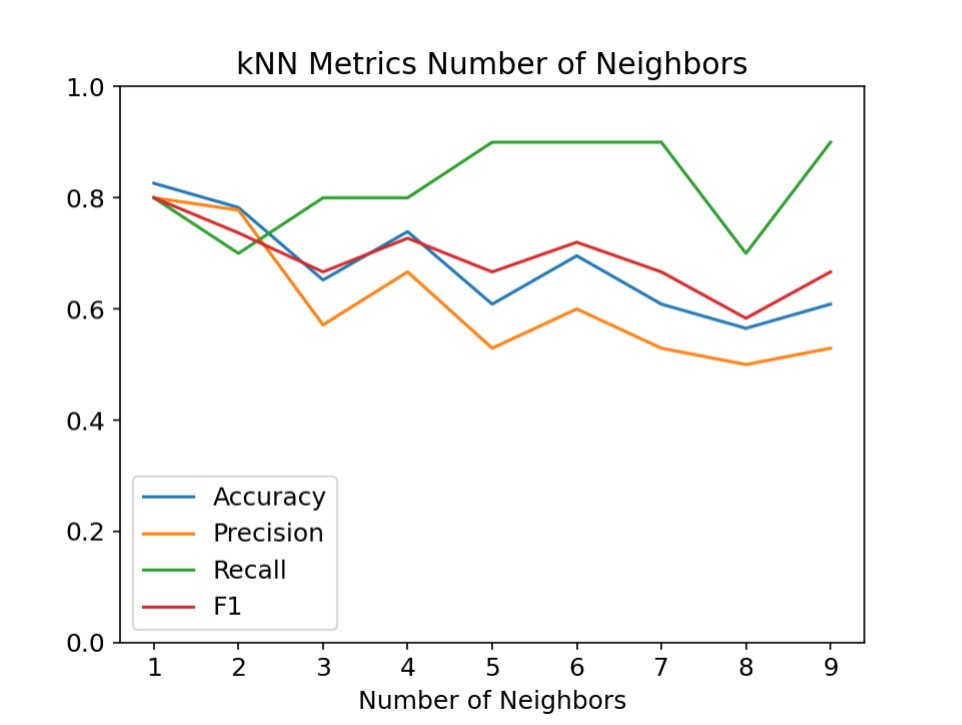
The results? 40% true negatives, 30% true positives, 20% false negatives and 10% false positives out of 23. Not terrible, not amazing. When training on the full sample of 112 (no separate testing), things improved as expected (50% true negatives, 44% true positives, 6% false negatives and 0% false positives). While a bigger training set always helps, we refrain from it in machine learning.
Since the classifier did a fair first-pass job at identifying known perturbed galaxies (see the right panel of Fig. 9), I tested the model on a second WALLABY field, NGC5044, which had more galaxies. This provided a first look at the fraction of perturbed systems in that region (see Fig. 11), setting the stage for more detailed follow-up.
So, what did we learn? The kNN classifier does a decent job of estimating the overall fraction of perturbed galaxies in a field, but for individual cases, it’s more of a prediction than a certainty. With an accuracy of ~80%, it’s still wrong 1.5 times more than we’d like. The good news? There are clear ways to improve this: better training sets and perhaps a more direct approach—like using HI maps to classify galaxies instead of relying on morphometrics first. Maybe a convolutional neural network trained on velocity maps instead of column density maps could be the way forward.
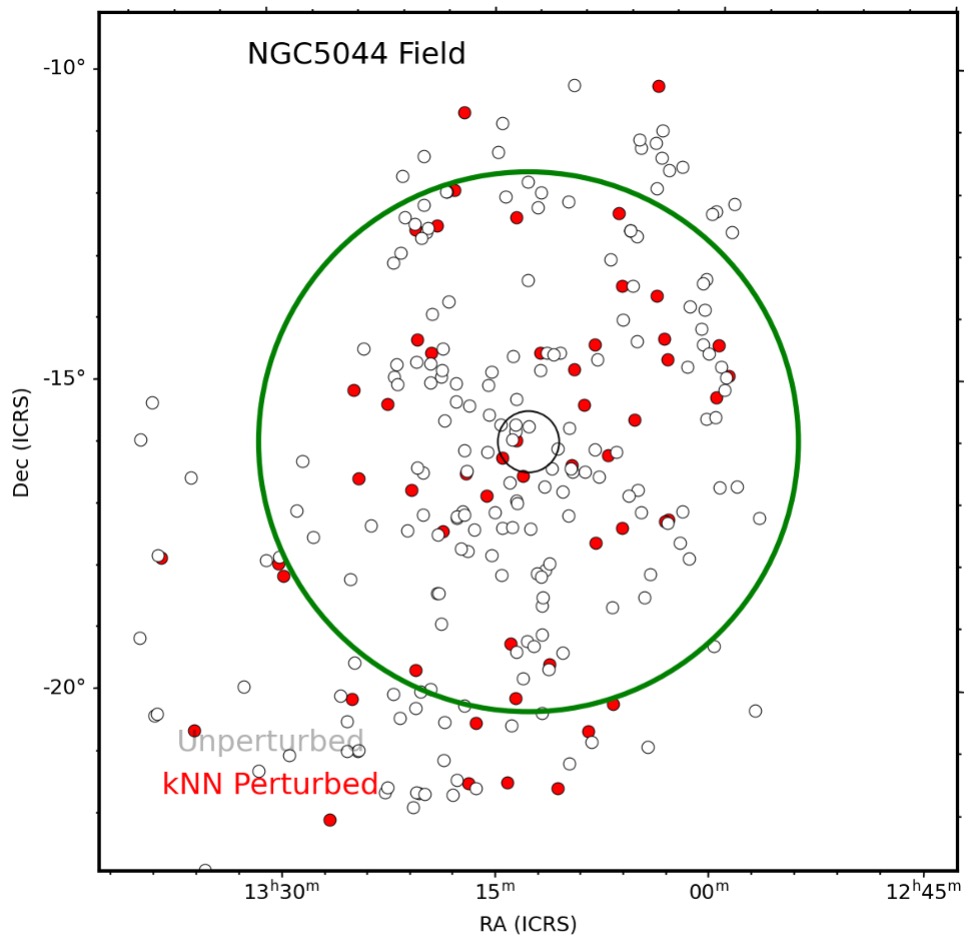
For now, we have a first-pass classifier, a set of perturbed galaxy predictions, and some new insights into applying machine learning to HI morphology. Let’s see where this takes us next.
Optimising Galaxy Distance Measurements from the WALLABY Tully-Fisher Relation
by Manreet Kaur, Paula Boubel & Matthew Colless
WALLABY is expected to detect around 200,000 galaxies in HI. About 50,000 of WALLABY’s detections will have sufficiently high-quality HI spectra to be suitable for distance measurements using the Tully-Fisher relation, significantly enhancing the existing database of redshift-independent distances (Koribalski et al., 2020).
For the first seven WALLABY fields released (Norma, Hydra, Eridanus, NGC4636, NGC4808, NGC5044, and Vela), Courtois et al. (2023) and Mould et al. (2024) used hyperfit (Robotham & Obreschkow, 2015) to recover an initial Tully-Fisher relation for the galaxies in these clusters/groups. They assumed zero peculiar velocities for the set of galaxies used as calibrators, neglecting the effect of these peculiar velocities on the observed redshifts and distances, and assumed that the Tully-Fisher relation of the calibration subsample is representative of the Tully-Fisher relation for the whole sample. The linear regression used to fit the Tully-Fisher relation takes no account of the curvature of the relation for large galaxies or of the sample selection function.
To improve on this initial determination of the WALLABY Tully-Fisher relation, we use the comprehensive forward-modelling Bayesian framework described in Boubel et al. (2024). Our approach simultaneously and self-consistently estimates the peculiar velocity field along with the Tully-Fisher relation parameters, fitting the entire dataset and directly incorporating the impact of peculiar velocities on the observed data. Our model for the Tully-Fisher relation incorporates both a curved relation and varying scatter along the relation. Moreover, our method explicitly models and corrects for the effects of the sample selection function.
In our analysis of the existing WALLABY data, we found that this HI-selected sample is only complete up to the Wide-field Infrared Survey Explorer (WISE) 3.4 micron magnitude, W1 = 7.7. The initial Tully-Fisher relation fit to this data did not account for the significant incompleteness affecting fainter galaxies and consequently was severely biased by this magnitude selection effect. We have explicitly modelled this selection criterion to correct the parameters of the Tully-Fisher relation, so that it takes account of the fainter galaxies. Our Tully-Fisher relation fit, shown in Fig. 12, has a slightly different slope than the linear regression and a significantly different zero-point.
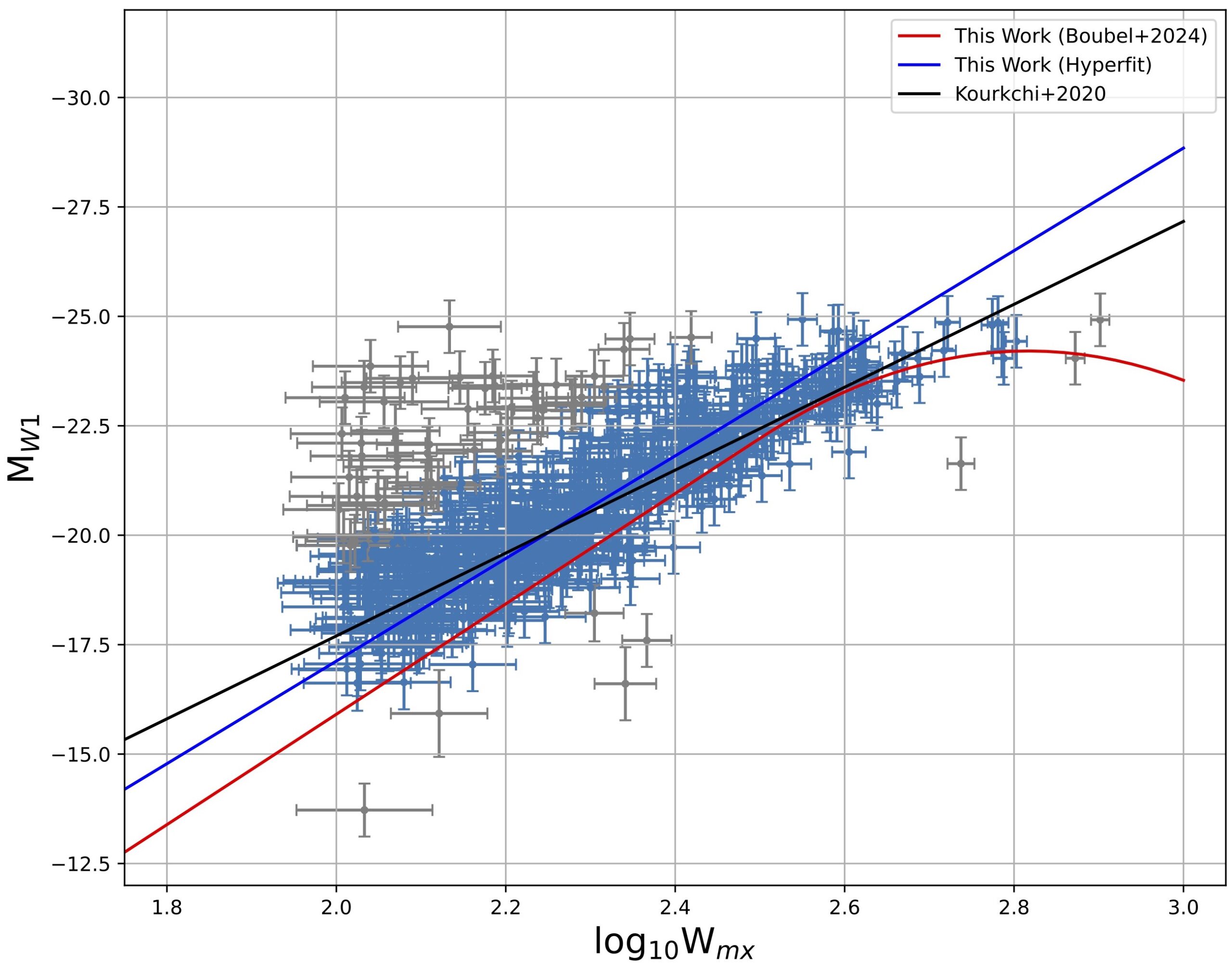
We then used the Tully-Fisher relation to derive peculiar velocities for the main cluster/group in each of the seven fields and found that, with the current data, only the peculiar velocity of Hydra was statistically significant (at > 5σ). With the far larger sample of WALLABY data yet to come, we expect that the forward-modelling machinery we have introduced will yield substantially more accurate and precise distances for WALLABY galaxies once the survey’s sample selection effects are fully characterised.
Upcoming Meetings & Workshops
Note: WALLABY team members can download PDF copies of several WALLABY-related presentations at international meetings from the Redmine wiki under “WALLABY-related presentations and material”.
| When | What | Where |
| 2025 Feb 20 | Monthly WALLABY Science Meeting* | Online |
| 2025 May 12-15 | Beyond Earth: Lunar and Space Radio Missions | ASTRON, Netherlands |
| 2025 May 27-30 | Simulation Based Inference for Galaxy Evolution | Bristol, United Kingdom |
| 2025 Jun 2-6 | IAUS 397 – UniverseAI: Exploring the Universe with Artificial Intelligence | Athens, Greece |
| 2025 Jun 16-20 | SKAO General Science meeting | Görlitz, Germany |
| 2025 Jun 16-20 | Dancing in the Dark: When Galaxies Shape Galaxies | Sexten, Italy |
| 2025 Jun 30-Jul 4 | Quo Vadis Galaxy Evolution? | Heidelberg, Germany |
| 2025 Jul 1-5 | 5th International CM3P Conference | Porto, Portugal |
| 2025 Aug 10-15 | Galaxy memoirs – inferring their past from their present | Búzios, Brazil |
| 2025 Aug 18-21 | Hungry HIppos: HI Workshop | Kruger Park, South Africa |
| 2025 Sep 22-26 | PHISCC Workshop 2025 | Cagliari, Italy |
WALLABY Publications
Aug 2024 – Feb 2025:
- Wang L., Wong O.I., Westmeier T., Murugeshan C., Lee-Waddell K., Cai Y., Liu X., et al., 2024, WALLABY Pilot Survey: HI source-finding with a machine learning framework, accepted for publication in PASA. doi:10.48550/arXiv.2409.11668
- Huang Q., Wang J., Lin X., Oh S.-H., Chen X., Catinella B., Deg N., et al., 2024, WALLABY Pilot Survey: Star Formation Enhancement and Suppression in Gas-rich Galaxy Pairs, accepted for publication in ApJ. doi:10.48550/arXiv.2410.22406
- Murugeshan C., Deg N., Westmeier T., Shen A. X., For B.-Q., Spekkens K., Wong O. I., et al., 2024, WALLABY Pilot Survey: Public data release of ∼ 1800 H I sources and high-resolution cut-outs from Pilot Survey Phase 2, PASA, 41, e088. doi:10.1017/pasa.2024.91
- Deg N., Arora N., Spekkens K., Halloran R., Catinella B., Jones M. G., Courtois H., et al., 2024, WALLABY Pilot Survey: Gas-rich Galaxy Scaling Relations from Marginally Resolved Kinematic Models, ApJ, 976, 159. doi:10.3847/1538-4357/ad84ba
- Perron-Cormier M., Deg N., Spekkens K., Richardson M. L. A., Glowacki M., Oman K. A., Verheijen M. A. W., et al., 2025, WALLABY Pilot Survey & ASymba: Comparing HI Detection Asymmetries to the SIMBA Simulation, accepted for publication in ApJ. doi:10.48550/arXiv.2501.09547
- Holwerda B. W., Denes H., Rhee J., Leahy D., Koribalski B., Yu N., Deg N., et al., 2025, WALLABY Pilot Survey: kNN identification of perturbed galaxies through HI morphometrics, accepted for publication in PASA. doi:10.48550/arXiv.2501.10563
A complete list of WALLABY ADS libraries can be found at https://wallaby-survey.org/papers
WALLABY Science Projects
Team members are reminded to regularly check the list of Current Projects list, linked on our internal Redmine wiki. If you are interested in contributing to any of these existing science projects, please feel free to get in touch with the PI of the project in question.
